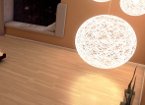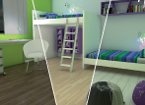Serving as the interface are real floor treatment patterns, which guarantee that the images are almost identical to the real products, and also deliver a very realistic feel of the depicted surfaces. Small sections of flooring studded with RFID chips are placed onto the interface console, and this triggers the laying of the new flooring. The customer can now move about freely in the Virtual Apartment, modify the lighting situation and view the surface structure from all possible angles and distances in order to get a comprehensive impression of how the flooring works with respect to space and light. These impressions would otherwise be available only in a specially constructed, modifiable showroom with enough space for each type of floor covering.
Realistically depicting the different varieties of flooring posed a particular challenge. In addition to accommodating subtle surface textures, diffuse reflections and special color characteristics such as glittering particles, consideration also had to be given to realistic automatic application of the floor. Accordingly, the basis for each floor treatment is delivered by the same digital graphics that are used for the production process itself.
The Virtual Apartment serves as one successful example for the forward-looking implementation of VR-technologie in effective sales promotion.
| |
|
|
|
|
||

